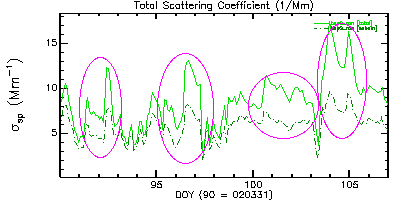A paper describing our Asian dust research in more detail was published in the IEEE proceedings in 2005. A brief synopsis is given below. Dust storms from the desert regions of Asia have been wreaking havoc on air quality over Korea and Japan dramatically in recent years. These spring season dust storms can be severe enough to degrade visibility and air quality causing serious health effects and economic effects as well, for example cancellation of commercial airline flights. The storms are easily detected by satellite images:

These photos show Asian dust (brownish yellow plumes) being blown from the Gobi desert over the Sea of Japan in early April 2002. Because of typical air flow patterns (arrows on plots) dust can be transported across the Pacific Ocean to North America, in five to seven days. Recent satellite images have even shown images of dust on the west coast of Alaska.
These SeaWiFS images were obtained from NASA. Additional information and satellite images can be obtained from the SeaWiFs web page.
The Global Monitoring Division has been making a variety of in situ and remote atmospheric and solar measurements at the Barrow, Alaska baseline observatory, location: 71.32° N, 156.60° W, (BRW) since 1973. The site was chosen to represent a remote arctic environment and aside from the town of Barrow, the station is far from any source of anthropogenic emissions. Because of its remoteness and the long term record of measurements at BRW, it is relatively easy to identify measurements made during incursions of polluted air to the site. A variety of measurements and model results indicate the occurrence of four potential dust events at BRW during the first half of April 2002.

The aerosol monitoring system at BRW (funded by Department of Energy/Atmospheric Radiation Measurements (DOE/ARM)) has observed several periods between April 1 and April 16 where there was an enhanced presence of supermicrometer aerosol particles, a good indicator of the presence of dust. In the two plots below, dust events are circled in pink.

This plot shows the total (dp<10 um)(solid line) and submicron (dp<1 um) (dashed line) 550 nm light scattering coefficient. Two things are seen on this plot: (1) light scattering during the dust events is not necessarily higher than the median (non-dust influenced) value of scattering (10 Mm-1). (2) during the dust events, particles larger than 1 um can cause up to ~50% of the scattering (typically at BRW super micron particles are responsible for less than 20% of the scattering in the spring).

This plot shows the Angstrom exponent for the 550/700 nm wavelength pair. During dust events the Angstrom exponent decreased to less than 1.0. (Angstrom exponent is inversely proportional to particle size.) The 25 year median value of Angstrom exponent at BRW is 1.8, and a value less than 1.0 is very unusual.
In addition to the surface measurements described above, there are also instruments at Barrow which measure atmospheric aerosols throughout the vertical column. One such instrument is the sunphotometer. The sunphotometer measurements give an indication of how much aerosol is in the atmosphere above the measurement site and this measurement is called aerosol optical depth. Spectral data from the sunphotometer give additional information about aerosol properties, e.g., size inferred from Angstrom exponent.
 In these images, spectral aerosol optical depth and the associated Angstrom exponent for 412/675 nm wavelength pair
are plotted for the same time period as the surface measurements shown above.
The sunphotometer is limited to making measurements during daylight hours on clear (not cloudy) days, so there are gaps in the data,
due to overcast skies. Three of four of the dust events observed at the surface are
also seen in the sunphotometer data. See how aerosol optical depth and particle size (as indicated by Angstrom exponent) vary at the Poles as a function of aerosol type.
In these images, spectral aerosol optical depth and the associated Angstrom exponent for 412/675 nm wavelength pair
are plotted for the same time period as the surface measurements shown above.
The sunphotometer is limited to making measurements during daylight hours on clear (not cloudy) days, so there are gaps in the data,
due to overcast skies. Three of four of the dust events observed at the surface are
also seen in the sunphotometer data. See how aerosol optical depth and particle size (as indicated by Angstrom exponent) vary at the Poles as a function of aerosol type.
Another instrument, the micropulse lidar, at the Barrow site is able to provide vertical resolution of clouds and aerosols in the atmosphere.

This plot shows micropulse lidar backscatter profiles for the dust event on April 11-12 (DOY 101-102). It shows layers of dust/haze descending over Barrow that originated in Asian deserts about 8 days earlier.
The plot is courtesy of the North Slope of Alaska site run by the Department of Energy's Atmospheric Radiation Measurements (DOE/ARM) program.
